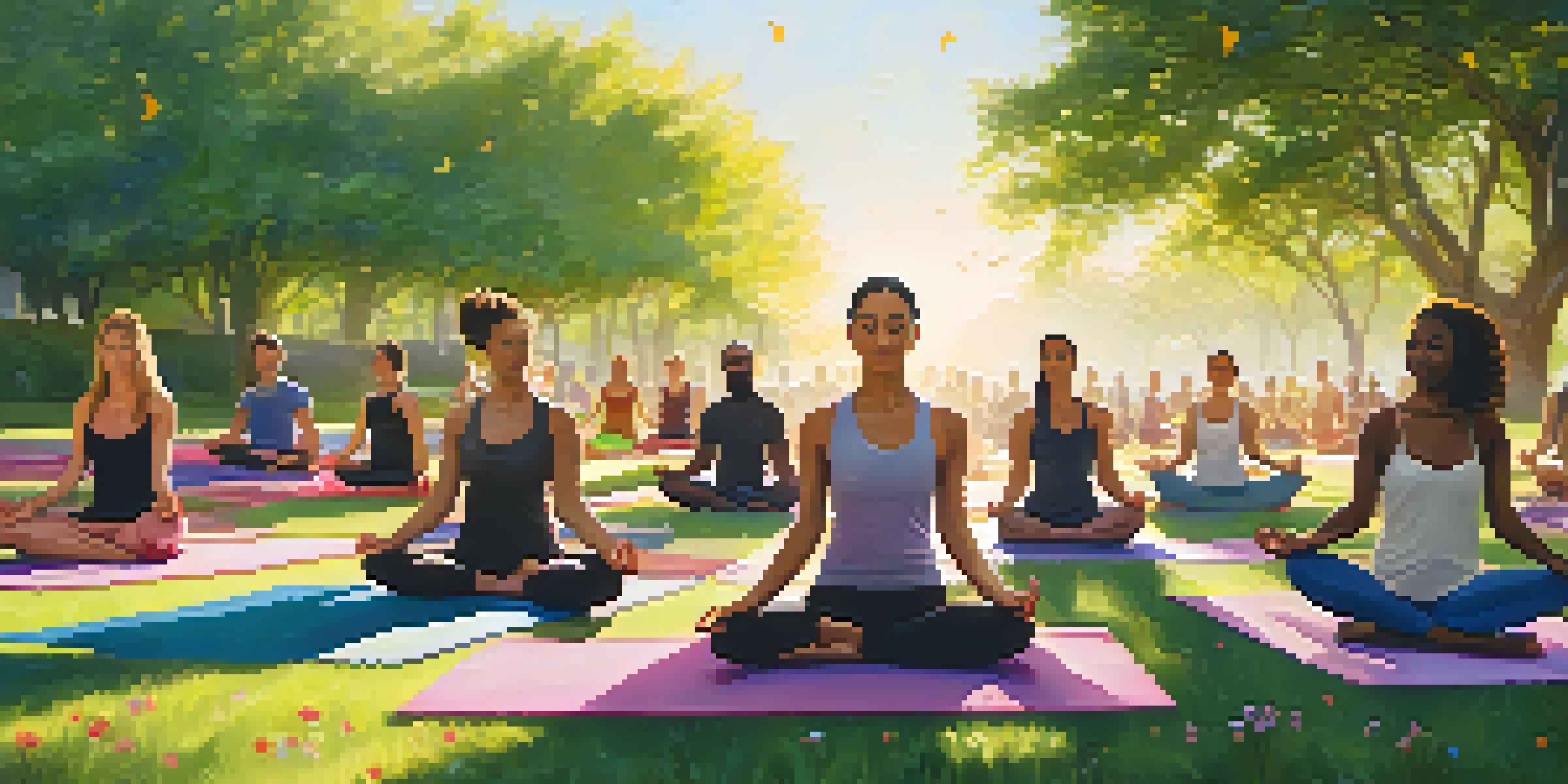Group Yoga Sessions: Finding Community While Grieving

Understanding Grief and Its Impact on Daily Life
Grief is a complex emotional response that can leave individuals feeling isolated and overwhelmed. When we lose someone we love, it can feel like the world has shifted beneath our feet, making everyday tasks seem insurmountable. Understanding the various stages of grief can help individuals navigate their feelings, but it often requires support from others who understand what they’re going through.
Grief is not a sign of weakness, nor a lack of faith... It is the price of love.
Many people experience grief in different ways, whether it's through sadness, anger, or even numbness. This emotional rollercoaster can make it challenging to connect with others, leading to a sense of loneliness. It’s important to acknowledge these feelings, as they are a natural part of the healing process.
Group settings, like yoga classes, can provide a safe space where individuals can come together and share their experiences. This sense of community can be vital for those navigating the tumultuous waters of grief, allowing them to find comfort among others who share similar feelings.
How Group Yoga Provides Emotional Support
Participating in group yoga sessions can offer individuals a unique form of emotional support. The shared experience of practicing yoga together fosters a sense of belonging, reminding participants that they are not alone in their grief. The collective energy in a class can be uplifting, creating an atmosphere of compassion and understanding.

Yoga itself encourages mindfulness and self-reflection, helping individuals process their emotions in a healthy way. As participants move through poses and focus on their breath, they may find moments of peace amid the chaos of their feelings. This practice can serve as a gentle reminder that healing is a journey, and it’s okay to take it one step at a time.
Grief is a Unique Emotional Journey
Everyone experiences grief differently, and understanding its stages can help individuals navigate their feelings.
Moreover, the bonds formed in these group settings often extend beyond the yoga mat. Participants may find themselves sharing stories and supporting each other, creating lasting connections that can help ease the burden of grief.
Creating a Safe Space for Vulnerability
One of the greatest benefits of group yoga sessions is the creation of a safe space for vulnerability. In a supportive environment, individuals can express their feelings without fear of judgment. This kind of openness can be incredibly healing, allowing participants to release pent-up emotions in a way that feels safe and constructive.
In the middle of difficulty lies opportunity.
Yoga instructors often set the tone for these sessions, encouraging participants to honor their feelings and take gentle care of themselves. This nurturing environment helps individuals feel understood and accepted, which is crucial when navigating grief. It also promotes the idea that it’s okay to not be okay, fostering a culture of empathy among participants.
As group members share in their vulnerability, they often find strength in one another. This shared experience creates a sense of camaraderie, reminding everyone that they are part of a community that understands their struggles.
Mindfulness Practices in Yoga for Grief Management
Mindfulness is a core component of yoga that can be particularly beneficial for those experiencing grief. Through mindfulness practices, participants learn to focus on the present moment, which can help quiet the mind’s tendency to dwell on painful memories. This shift in focus can be a powerful tool for managing overwhelming emotions.
Techniques such as deep breathing and meditation incorporated into yoga sessions encourage individuals to connect with their bodies and emotions. By tuning into their physical sensations, participants can better understand their grief and its manifestations, allowing for a more holistic healing process.
Group Yoga Fosters Community Support
Participating in group yoga sessions creates a sense of belonging, allowing individuals to share their grief in a supportive environment.
As practitioners cultivate mindfulness, they may find it easier to navigate the complexities of their feelings. This newfound awareness not only aids in grief management but also enhances overall well-being, leading to a more balanced emotional state.
Building Connections Outside the Yoga Studio
The connections formed during group yoga sessions can extend beyond the studio, creating a supportive network for those in grief. Participants may choose to meet for coffee or join support groups, further solidifying the friendships they've cultivated. These connections can be incredibly healing as individuals share their journeys and provide mutual support.
Having a community of people who understand the nuances of grief can alleviate feelings of loneliness. It offers a sense of normalcy and validation, reminding individuals that their feelings are shared and understood. This ongoing support can be a crucial element in the healing process.
Additionally, sharing resources, such as books or articles on grief, can further enrich these connections. By continuing the conversation outside of yoga, participants can reinforce the sense of community that helps them navigate their grief.
Incorporating Rituals into Group Yoga Sessions
Rituals can play a significant role in the healing process, providing structure and meaning during times of loss. Incorporating rituals into group yoga sessions, such as lighting a candle or dedicating a pose to a loved one, can help participants honor their grief in a tangible way. These small acts can foster a sense of connection to the person they've lost, making the experience feel more personal.
Such rituals also create an atmosphere of reverence and reflection, allowing individuals to pause and acknowledge their feelings. This shared ritual can deepen the bond between participants, as they collectively navigate their grief while honoring their loved ones.
Rituals Enhance the Healing Process
Incorporating rituals into yoga sessions provides participants with meaningful ways to honor their grief and connect with their loved ones.
Moreover, these practices serve as a reminder that grief is not a solitary journey. By participating in rituals together, individuals can find solace in the knowledge that they are surrounded by a community that understands and supports them.
Finding Hope and Healing Through Community
Ultimately, group yoga sessions can be a powerful source of hope and healing for those experiencing grief. The combination of movement, mindfulness, and shared experiences creates a unique environment that nurtures emotional well-being. Participants often leave feeling lighter, more connected, and with a renewed sense of purpose.
The sense of community that develops within these sessions promotes resilience, reminding individuals that they are not alone in their struggles. As they move through their grief, the support of others can provide encouragement and strength, making the journey feel more manageable.

By embracing the healing power of community, individuals can transform their grief into a source of connection and growth. Group yoga sessions become more than just a form of exercise; they evolve into a vital lifeline for those seeking solace amid their pain.